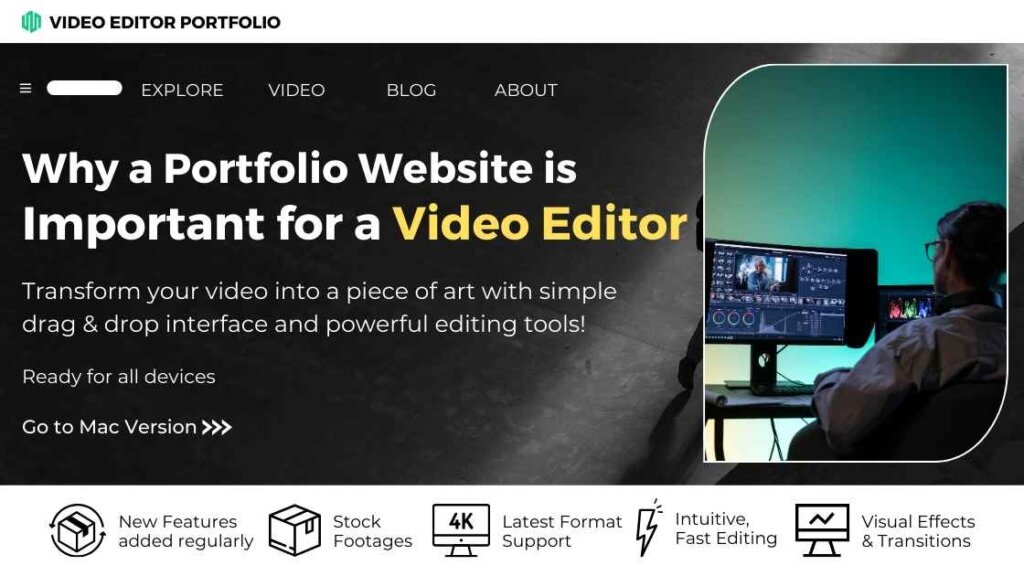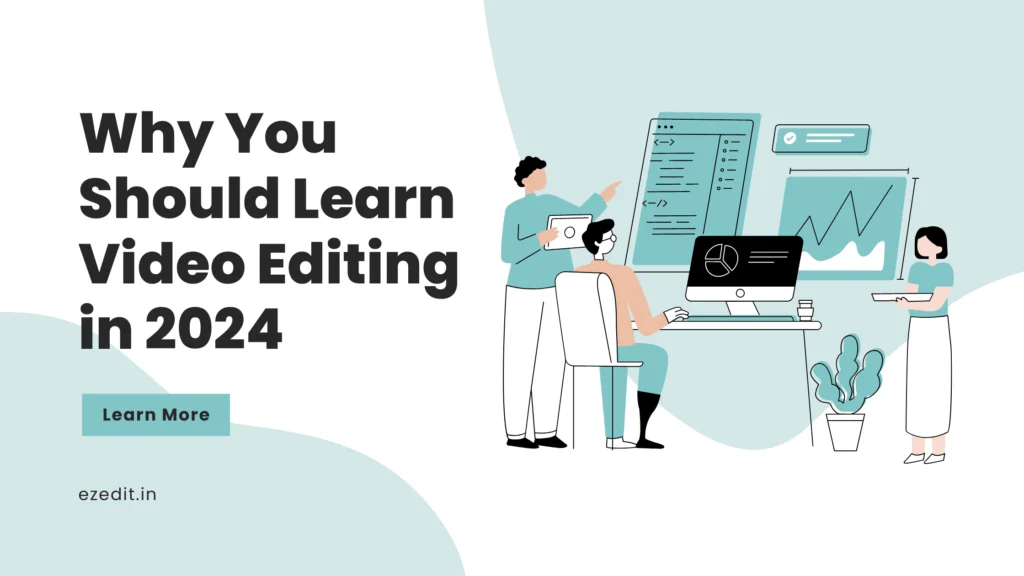As the digital world continues to evolve, the demand for video content has skyrocketed. Businesses, brands, and influencers are all realizing the value of visual media in connecting with their audience. As a video editor, this explosion in demand opens up new opportunities, but it also brings competition. To stand out and attract clients, having a portfolio website has become essential. Whether you’re a freelance video editor or looking to join a production house, a portfolio website for a video editor serves as your digital storefront and offers you the chance to showcase your creativity, skills, and experience.

In this detailed guide, we’ll explore the importance of having a portfolio website for video editors, how it can help you grow your career, and actionable steps to create an effective portfolio that resonates with potential clients.
What is a Portfolio Website?
A portfolio website is a personal website where creatives—such as video editors, photographers, graphic designers, and more—showcase their work. For video editors, a portfolio is an online space where you can display various editing projects, such as commercials, music videos, short films, corporate videos, and other content you’ve worked on. A well-structured portfolio will highlight your best work, showcase your range of editing styles, and give potential clients or employers an easy way to evaluate your skills.
Think of your portfolio website as your professional resume. Instead of listing qualifications on a piece of paper, it gives you the opportunity to showcase your actual work. It also serves as a place where people can learn about your creative process, discover the services you offer, and contact you for projects.
Why Do Video Editors Need a Portfolio Website?
In a world where a simple social media profile or a résumé isn’t enough to secure clients, video editors need a portfolio website to stand out. Here are several key reasons why having a portfolio is critical to your success:
1. Show Your Best Work in One Place
When you have a portfolio website, you have the freedom to curate a collection of your best video editing projects. Unlike social media or platforms like YouTube where your content can get buried in the feed, your portfolio website allows you to showcase selected works, emphasizing quality over quantity. By having a website that serves as your digital home, you gain complete control over the narrative of your career.
2. Attract Potential Clients
When potential clients are looking to hire a video editor, they need a way to see your skills and style. A portfolio website serves as the first impression many clients will get of you. If your website is clean, professional, and showcases high-quality work, you’ll have a much higher chance of impressing and winning over clients. Without a portfolio, it may be challenging for clients to evaluate your editing skills.
3. Build Trust and Credibility
Having a portfolio website conveys professionalism and commitment to your craft. It shows that you’re serious about your work and willing to invest in your career. Clients are more likely to trust you with their projects if they can see examples of your previous work and read testimonials from satisfied clients.
4. Stand Out in a Competitive Market
The world of video editing is competitive, and clients have many options to choose from. To differentiate yourself from others, you need a well-crafted portfolio website. It can be your unique selling point (USP) to stand out from other video editors in your area or niche. A professional-looking portfolio can demonstrate not only your technical skills but also your ability to tell compelling visual stories through editing.
5. Demonstrate Your Skills and Services
A portfolio website allows you to not only showcase your previous work but also highlight the range of video editing services you offer. Whether it’s color grading, sound design, VFX, motion graphics, or editing for specific platforms like YouTube, a portfolio website provides a platform to explain and demonstrate the depth of your skills.
6. Build Your Online Presence and Personal Brand
In today’s digital age, personal branding is crucial, especially for freelancers. A portfolio website allows you to build and strengthen your brand identity. By choosing a unique design, color scheme, and content structure, you can create an online presence that speaks to your personal style. It also helps you appear more professional to potential clients and employers.
Showcase Your Best Work
Your portfolio website is where you should display your finest editing work. Here’s how you can effectively showcase your projects:
- Project Highlights: Select your best projects that showcase your editing skills, style, and range. Ensure that these videos are high quality and relevant to the kind of clients you want to attract.
- Video Thumbnails: Make sure each project has an attractive thumbnail that entices visitors to click. This visual element should be professional and consistent.
- Diverse Portfolio: While you might specialize in one area (e.g., corporate videos or music videos), it’s important to showcase a variety of work to show your versatility. This can help clients see how you adapt to different project types.
- Behind the Scenes: Sometimes, clients like to see the process behind your work. Adding a brief description of each project or showing before-and-after edits can demonstrate your technical and creative process.
Attract Clients and Opportunities
A portfolio website for a video editor is not just about showcasing your skills; it’s also about attracting opportunities. A well-optimized site can help you reach potential clients, collaborators, and employers. Here’s how:
- SEO for Video Editing Portfolio: Use keywords that are relevant to your services and area of expertise. This will help your website rank higher in search engines and make it easier for potential clients to find you.
- Client Testimonials: Ask your past clients for testimonials or reviews that you can feature on your portfolio site. Positive reviews will help build trust and credibility with future clients.
- Contact Form and Call to Action: Make it easy for potential clients to get in touch. Include a simple contact form and a clear call to action, such as “Hire Me” or “Get a Quote.”
SEO Benefits for Video Editors
A portfolio website isn’t just a showcase—it’s an essential part of your SEO strategy. By optimizing your website with relevant keywords and content, you can improve your chances of ranking higher in search engine results. Here’s why SEO is crucial for a video editor’s portfolio:
- Increased Visibility: By targeting keywords such as “video editing services,” “freelance video editor,” or “motion graphics editing,” you can increase the likelihood of being discovered by people looking for these services.
- Local SEO: If you’re offering video editing services to a specific geographic region, optimizing your website for local SEO is essential. You can do this by including location-based keywords and creating a Google My Business listing.
- Content Optimization: Regularly updating your portfolio with new projects, blogs, or testimonials can help your website remain relevant and improve its search engine rankings.
The Key Elements of an Effective Portfolio Website
To build a portfolio website that attracts clients and showcases your talents, you need to include several key elements:
- Home Page: A clean, welcoming home page that introduces you as a video editor and offers easy navigation.
- Portfolio: A dedicated page where your work is displayed. You can break it into categories based on the type of projects (e.g., corporate, music videos, etc.).
- About Me: A personal bio where you talk about your experience, your editing style, and your career journey.
- Services: A page where you list the specific services you offer (color grading, motion graphics, etc.) and pricing information (if relevant).
- Testimonials: A section where clients can read positive reviews from your past work.
- Blog: A blog where you share industry tips, tricks, and updates on your work.
- Contact Form: A simple contact form that allows potential clients to reach out to you for collaborations or projects.
How to Create Your Portfolio Website
Building a portfolio website is easier than ever with the variety of platforms available today. Here’s how you can start:
- Choose a Website Builder: Use platforms like WordPress, Wix, or Squarespace, which offer customizable templates for portfolio websites.
- Select a Domain Name: Choose a professional domain name that includes your name or business and is easy to remember.
- Design for User Experience: Make sure your website is easy to navigate and visually appealing. A clean, minimal design allows your work to take center stage.
- Optimize for Mobile: A large percentage of web traffic comes from mobile devices, so ensure your website is responsive and works well on smartphones.
Maintaining and Updating Your Portfolio
A portfolio website isn’t a one-and-done project. You need to regularly update it to keep it fresh and relevant. Here are a few ways to maintain your portfolio:
- Update Projects: As you complete new projects, add them to your portfolio. Continuously update your work to show that you’re active and evolving.
- Remove Outdated Work: If a project no longer reflects your current skills or standards, consider removing it to keep your portfolio looking polished.
- Blog Regularly: Keep your site dynamic by blogging about the latest trends in video editing or sharing your creative process.
Conclusion
In today’s competitive video editing industry, having a portfolio website is not just important—it’s essential. It’s your digital presence, your resume, and your portfolio all rolled into one. A well-structured portfolio website will help you showcase your best work, attract clients, and build a professional brand. By taking the time to create and maintain an effective portfolio, you’re not only positioning yourself as a skilled video editor, but you’re also opening doors to new career opportunities and growth.
Start building your portfolio website today and unlock the potential for a successful and fulfilling career in video editing.


